Master the Art of French Financiers: The Ultimate Brown Butter Almond Cakes Recipe
Indulge in the exquisite simplicity of classic French Financiers, delightful mini cakes renowned for their rich almond flavor and the nutty aroma of brown butter. These elegant treats are surprisingly quick and easy to prepare, making them an ideal project for bakers of all levels. Perfectly golden with a moist, tender crumb, Financiers are not only a sensational tea-time snack but also a brilliant way to utilize leftover egg whites. Discover the secrets to making these iconic French pastries that promise to enchant your taste buds with every bite.

Why You’ll Adore This Financiers Recipe
Financiers are, without a doubt, among the most cherished French pastries, offering a sophisticated yet utterly comforting experience. These mini almond cakes are celebrated for their distinctive qualities that make them stand out from other sweet treats. Here’s why this recipe will become a firm favorite in your baking repertoire:
- Unforgettable Flavor Profile: The star of the show is undoubtedly the brown butter (beurre noisette). This culinary technique transforms ordinary butter into a golden, fragrant elixir with a deep, nutty, and slightly caramelized flavor that infuses every bite of the financier. Combined with fine almond meal, it creates an unparalleled richness that is both delicate and complex.
- Effortlessly Elegant: Despite their refined appearance, financiers are incredibly quick and simple to prepare. This recipe requires no stand mixer and minimal equipment, making it perfect for spontaneous baking sessions. The batter comes together in minutes, proving that gourmet taste doesn’t have to mean complicated processes.
- Remarkably Versatile: While delicious in their classic form, financiers are a blank canvas for creativity. They can be easily customized with a myriad of additions – from fresh berries and citrus zest to chocolate chips or a medley of different nuts. Explore variations like Chocolate Financiers or Coffee Financiers to suit any craving or occasion.
- The Perfect Use for Leftover Egg Whites: If you often find yourself with excess egg whites after making custards, meringues, or other egg-yolk-heavy recipes like Crème Pâtissière (Pastry Cream), Crème Brulée, or rich Ice Cream, financiers are your ultimate solution. This recipe specifically calls for egg whites, ensuring nothing goes to waste while creating something truly delicious.
- Light and Tender Texture: Thanks to the almond flour and the specific preparation method, these cakes boast a wonderfully moist, soft, and airy crumb that simply melts in your mouth. They are light enough to enjoy guilt-free yet rich enough to satisfy your sweet tooth.
What Exactly Are French Financiers?
A “Financier,” originally known as “visitandine,” is a small French almond cake, a quintessential component of French patisserie. These exquisite little cakes are primarily characterized by the use of almond flour and, most importantly, brown butter, or “beurre noisette” in French, which imparts a unique depth of flavor. While they can be enjoyed in their pure, unadulterated form, financiers are also often enhanced with various flavors, including fresh fruits, chocolate, aromatic spices, or other types of nuts. Their texture is famously moist, dense yet light, with a delicate crust.
Financiers are also famous for their distinctive shape. Traditionally, they are baked in small rectangular molds, which give them the appearance of miniature gold bars. This iconic shape is believed to be one of the inspirations behind their intriguing name. However, it’s not uncommon to find them in other elegant shapes, such as the oval molds used in some contemporary recipes, or even round mini-muffin tins, without sacrificing any of their charm or flavor.
The Intriguing Origin of the Name “Financier”
The name “Financier” itself adds a layer of mystique to these delightful French cakes, with a couple of popular theories explaining its origin:
- The Gold Bar Theory: The most widely accepted theory attributes the name to the distinctive rectangular shape of the cakes. When baked in their traditional molds, financiers perfectly resemble small ingots or bars of gold. This visual similarity led people to associate them with wealth and finance.
- The Parisian Stock Exchange Connection: Another compelling theory suggests that these cakes were particularly popular among the bustling financiers and traders working at the Paris stock exchange in the late 19th century. The cakes were conveniently small, allowing them to be easily eaten without making a mess, and could be tucked into a pocket. Their simple, elegant nature made them an ideal quick snack for busy professionals who likely appreciated a sophisticated treat during their demanding workdays. This connection to the financial world further solidified their unique name.
Regardless of the precise origin, the name “Financier” perfectly encapsulates the rich history and refined character of these beloved French almond cakes.
Essential Ingredients for Perfect Financiers
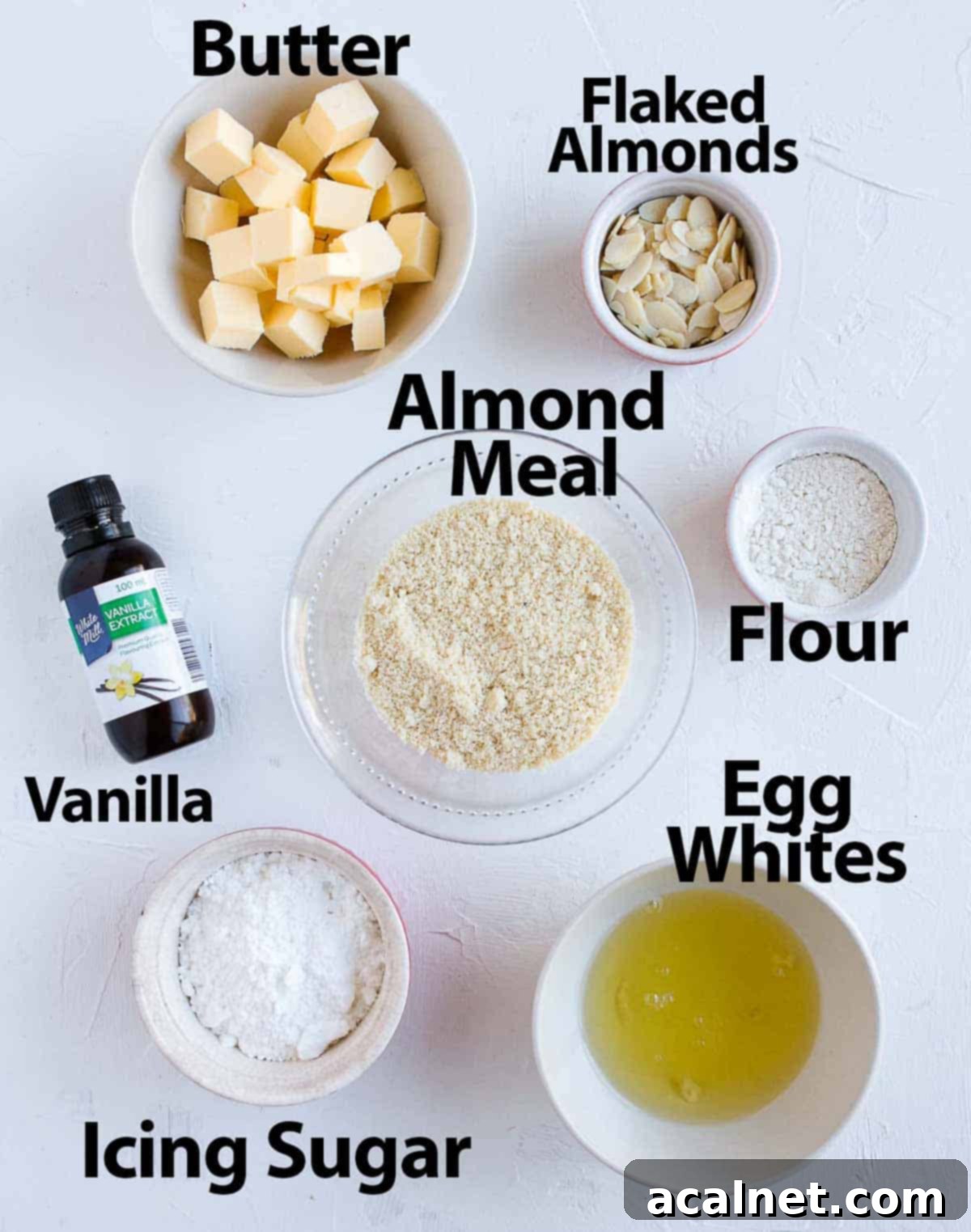
For precise quantities and measurements, please refer to the detailed recipe card provided below.
Crafting the perfect financier requires a careful selection of a few key ingredients. Each component plays a crucial role in achieving the signature taste and texture of these French almond cakes:
- Unsalted Butter (for Brown Butter): The foundation of flavor in financiers. We use unsalted butter, slowly melted and cooked on the stove to transform it into luscious brown butter (beurre noisette). This process caramelizes the milk solids, imparting a rich, nutty, and toasted aroma that is absolutely essential for authentic financier taste. While you *could* use plain melted butter, the depth of flavor from brown butter is unparalleled and highly recommended. Remember to cool the brown butter slightly before adding it to the batter to avoid cooking the egg whites prematurely.
- Dry Ingredients:
- Almond Meal (or Almond Flour): This is the primary flour for financiers, contributing to their distinctive almond flavor and wonderfully moist, tender crumb. Both almond meal (which often contains small bits of skin) and finer almond flour work beautifully, though almond flour may yield a slightly smoother texture.
- Plain / All-Purpose Flour: A small amount of all-purpose flour provides structure to the cakes. While I haven’t personally tested this recipe with gluten-free flour substitutes, a high-quality 1:1 gluten-free baking blend might work, but results may vary.
- Icing Sugar (Confectioners’/Powdered Sugar): Used for its fine texture, icing sugar blends seamlessly into the batter, ensuring a smooth consistency and a delicate sweetness. It also helps create that desirable crisp exterior.
- A Pinch of Salt: A tiny but mighty ingredient that balances the sweetness and enhances all the other flavors, making them pop.
Ensure all dry ingredients are thoroughly sifted before combining them to prevent any lumps and to create a light, airy batter.
- Egg Whites: Financiers are unique in that they exclusively use egg whites, giving them their characteristic light and airy texture. While some recipes call for straight egg whites, I prefer to lightly whisk them until a subtle foam appears. This gentle whisking incorporates air, acting as a natural leavening agent in the absence of baking powder, making the financiers even lighter and fluffier. This is also why they are the perfect way to use up egg whites from other recipes.
- Optional Flavor Enhancers & Toppings:
- Vanilla or Almond Extract: A touch of extract can deepen the overall flavor profile. Vanilla adds a classic warmth, while almond extract can heighten the natural almond notes.
- Flaked Almonds: Sprinkled on top before baking, flaked almonds add a lovely crunch and visual appeal, complementing the almond-rich interior.
Exciting Variations and Flavor Combinations for Financiers
The beauty of the classic financier recipe lies in its adaptability. Once you master the basic brown butter almond cake, a world of creative possibilities opens up. Use this fundamental recipe as a springboard to experiment with various additions and flavor profiles:
- Fresh or Dried Fruits: Incorporate seasonal fruits into your batter for bursts of flavor and moisture. Think fresh berries like Raspberries or Blueberries, chopped Figs, pitted Cherries, small chunks of Pears or Apples, or the bright zest and juice of Citrus fruits like Orange and Lemon.
- Alternative Nuts and Flours: While almond is traditional, you can partially or fully replace the Almond Meal with other finely ground nut flours. Hazelnut flour or Pistachio flour would lend a wonderfully distinct flavor. You could also sprinkle chopped whole nuts (pecans, walnuts, hazelnuts) on top or fold them into the batter for added texture.
- Chocolate Indulgence: For chocolate lovers, financiers can be transformed into a decadent treat. Replace a small portion of the all-purpose flour with high-quality Cacao Powder for a chocolatey base, or fold in mini Chocolate Chunks or chips into the batter, as demonstrated in these delicious Chocolate Financiers.
- Aromatic Tea or Coffee: Infuse your financiers with sophisticated notes by adding finely ground Matcha tea powder for an earthy, vibrant flavor, or incorporate strong brewed Coffee for a delightful pick-me-up pastry.
- Warm Spices: Introduce warmth and complexity with your favorite baking spices. A touch of Cinnamon, Ginger, Allspice, Cardamom, or even a blend like pumpkin pie spice can elevate these simple cakes into something truly special, particularly during colder months.
Don’t be afraid to mix and match these additions to create your signature financier. The possibilities are endless, ensuring you’ll always have a new and exciting financier variation to explore.
Step-by-Step Guide: Crafting Irresistible Brown Butter Financiers
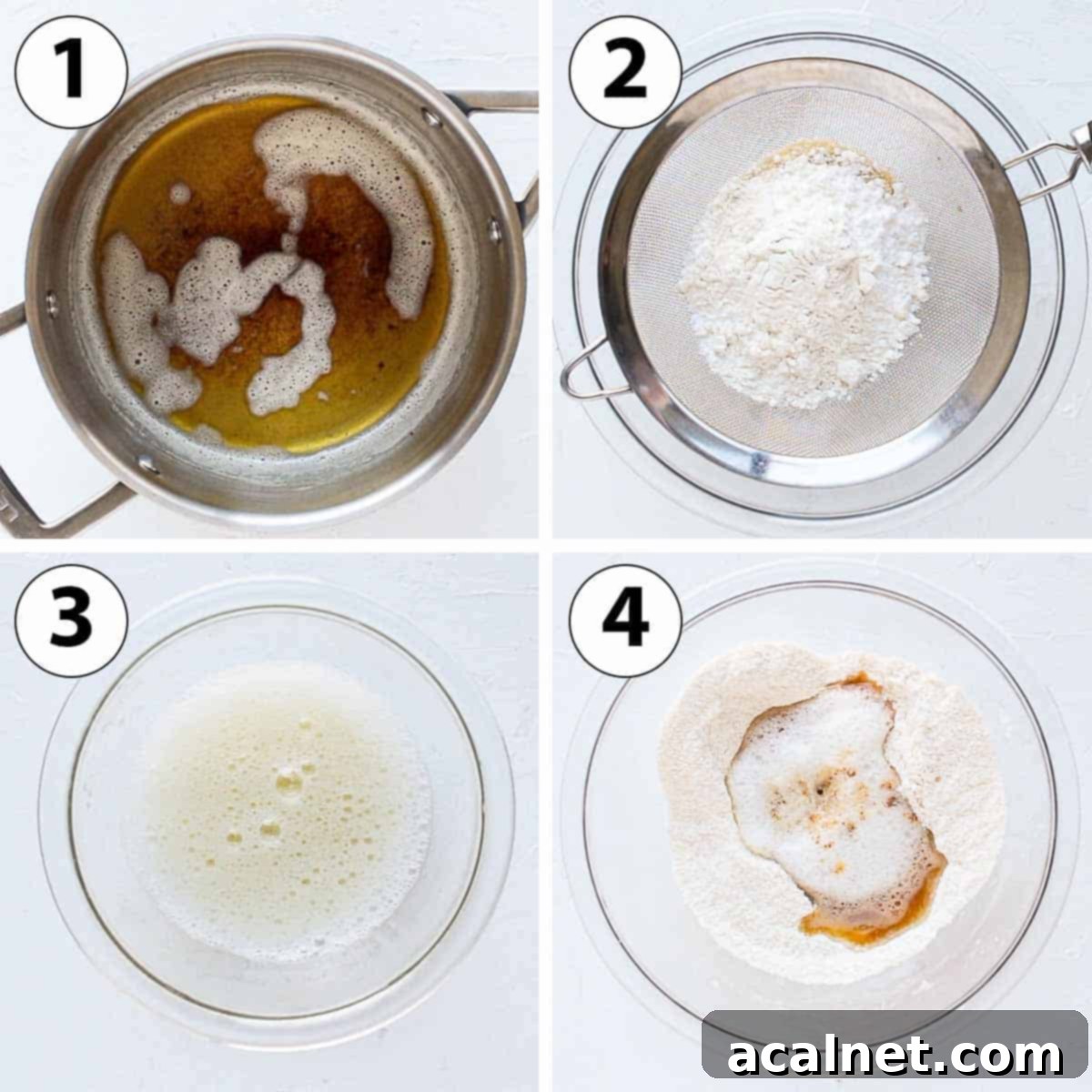
Making these elegant French Financiers is a rewarding and relatively simple process. You’ll need just a few basic kitchen tools: one saucepan for the brown butter, and two mixing bowls for combining your dry and wet ingredients. Let’s walk through the steps to achieve perfect, nutty almond cakes.
1. The Art of Making Brown Butter (Beurre Noisette)
- Step 1: Begin by placing your unsalted butter in a small, light-colored saucepan. A light-colored pan is crucial as it allows you to clearly monitor the color changes of the butter, preventing it from burning. Place the saucepan over medium-low to medium heat.
- Step 2: Allow the butter to melt completely, stirring occasionally to ensure even heating. As the butter melts, it will begin to foam. Continue to cook, stirring gently.
- Step 3: After approximately 5 to 8 minutes, you’ll notice a magical transformation. The butter will start to turn a beautiful golden-amber color, and your kitchen will fill with an incredibly inviting, rich, nutty aroma – reminiscent of toasted hazelnuts. At this stage, look for small brown specks forming at the bottom of the pan. These are the caramelized milk solids, which are packed with intense flavor.
- Step 4: As soon as you see these brown specks and smell that characteristic nutty fragrance, immediately remove the saucepan from the heat to prevent the butter from burning. Pour the brown butter, including all the precious brown bits, into a heatproof bowl. Set it aside to cool down slightly before incorporating it into your batter. This cooling step is important to ensure the butter doesn’t “cook” your egg whites when mixed.
2. Preparing the Light and Flavorful Financier Batter
- Step 1: Preheat your oven to 160°C (325°F). Prepare your Financier Pan (or chosen alternative, see FAQ notes) by generously greasing it. For an extra non-stick measure and a perfect golden crust, you can also lightly dust the greased molds with a little all-purpose flour, tapping out any excess.
- Step 2: In a large mixing bowl, meticulously sift together the almond meal, icing sugar (also known as powdered or confectioners’ sugar), all-purpose flour, and a pinch of salt. Sifting is vital here to remove any lumps and ensure a uniformly smooth and airy batter. Whisk these dry ingredients together thoroughly until well combined.
- Step 3: In a separate, clean bowl, lightly whisk your egg whites for a few minutes. You’re not looking for stiff peaks, but rather a light foam or just until they become slightly bubbly. This crucial step, while optional, incorporates air into the egg whites, which acts as a natural leavening agent for the financiers, resulting in a significantly lighter and more tender crumb.
- Step 4: Now, combine your wet and dry ingredients. Pour the slightly cooled brown butter (making sure to scrape every last flavorful brown speck from the saucepan!), the lightly whisked egg whites, and the vanilla extract (if using) into the bowl containing the dry ingredients. Stir gently with a whisk or spatula until just combined and you no longer see any visible lumps. Be careful not to overmix the batter; overmixing can lead to tougher cakes.

- Step 5: Carefully transfer the financier batter into your prepared pan. For a neat and even distribution, you can use a piping bag, then gently smooth the tops with the back of a spoon. Alternatively, a simple spoon or scoop will work just as well. Fill each mold about two-thirds full to allow for a slight rise.
- Step 6: For an added touch of texture and visual appeal, sprinkle a generous amount of flaked almonds on top of each financier. This step is entirely optional but highly recommended. You could also use other toppings like chopped pistachios, hazelnuts, or a few fresh blueberries or raspberries for a fruity twist.
- Step 7: Bake the financiers in your preheated oven for approximately 12 to 14 minutes. Baking time can vary slightly depending on your oven and the size of your molds. If you’re using a larger muffin or mini loaf pan, you might need to extend the baking time by a few minutes. The financiers are ready when they are lightly golden around the edges and spring back gently when touched in the center.
- Step 8: Once baked, remove the pan from the oven. Allow the financiers to cool in their molds for about 10-15 minutes. They will be quite delicate right out of the oven, so this cooling period helps them firm up and makes them much easier to release without breaking. Gently remove the financiers from their molds and transfer them to a wire rack to cool completely.

Financiers Recipe: Frequently Asked Questions
Both Financiers and Madeleines are celebrated classic French tea cakes, but they possess distinct characteristics in both taste and texture. The primary difference lies in their ingredients and leavening agents. Financiers are uniquely made with *only egg whites* and typically contain no additional chemical raising agents like baking powder, relying on the air incorporated into the egg whites for their light crumb. Madeleines, on the other hand, utilize *whole eggs* and often include baking powder to achieve their characteristic hump and tender texture.
Another notable difference is their traditional shape. While financiers are known for their rectangular “gold bar” form (or sometimes oval, as seen in this recipe), they can be baked in various small cake tins, including round muffin pans. Madeleines, however, are exclusively baked in their iconic shell-shaped madeleine molds, which give them their signature fluted design.
While you absolutely *can* substitute plain melted butter for brown butter in this recipe, it’s important to understand the significant impact this will have on the final flavor. The “brown butter” (beurre noisette) is a star ingredient in financiers, responsible for a large part of their deep, nutty, and complex taste profile. The process of browning butter caramelizes its milk solids, creating unique toasty notes that cannot be replicated with simply melted butter.
If you opt for melted butter, your financiers will still be delicious almond cakes, but they will lack the signature depth and richness that define true French financiers. Additionally, note that brown butter undergoes a reduction in weight during the browning process (due to water evaporation, usually around 15%). If substituting, you might need a slightly larger quantity of initial butter to yield the same amount of fat as brown butter, though for home baking, a direct substitution in volume often suffices without major issues.
Traditional financiers are indeed baked in specific rectangular financier molds, often seen as elegant “gold bars.” However, if you don’t possess these specialized baking tins, don’t let that deter you from making these delightful cakes! The most crucial aspect is the batter itself, not strictly the mold.
You can successfully bake financiers in a variety of other small cake pans. A regular muffin tin, mini-muffin tins, or even a mini loaf pan will work perfectly well. Just be aware that the baking time will need to be adjusted; smaller molds like mini-muffin tins will bake much faster, while larger molds might take a few extra minutes. For the best caramelization and a wonderfully crisp exterior, I highly recommend using a metal pan over silicone, as metal conducts heat more efficiently and promotes better browning.
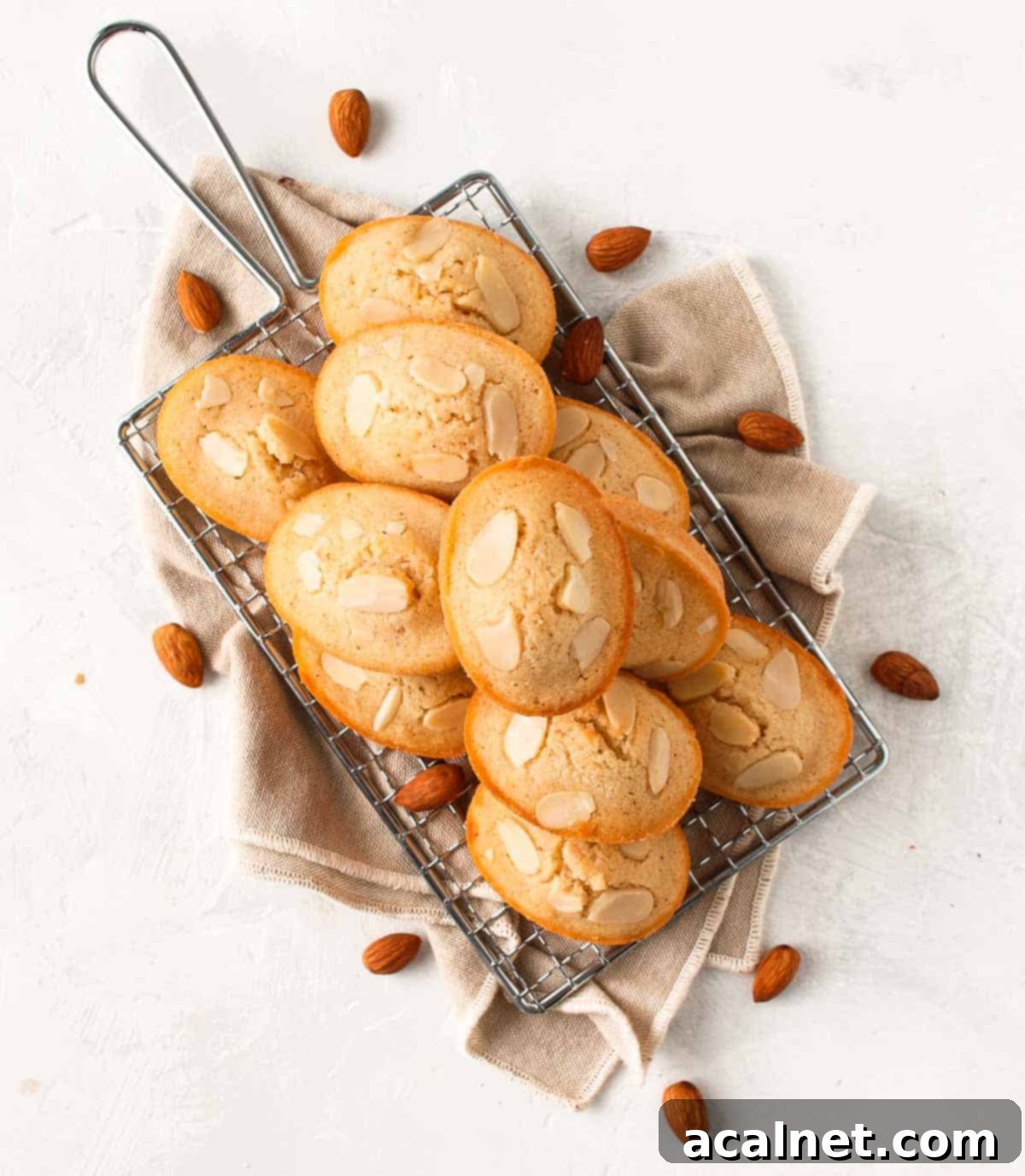
Expert Tips for Baking Perfect Financiers
Achieving perfectly tender, flavorful financiers is easier than you think, especially with a few insider tips. Follow these recommendations to ensure your brown butter almond cakes turn out beautifully every time:
- Chill the Batter for Enhanced Flavor: For an even deeper and more developed flavor, consider preparing your financier batter a few hours, or even a day, in advance. Cover the bowl with plastic wrap, ensuring the wrap touches the surface of the batter to prevent a skin from forming, and refrigerate it. Chilling allows the flavors to meld and intensify, resulting in an even richer financier. Bring the batter back to room temperature slightly before baking for optimal results.
- Grease Your Pan Generously: Financier batter can be a bit sticky, so it’s paramount to generously grease the cake tin you’re using. Buttering and then lightly flouring the molds can create an extra barrier against sticking. If, after baking and cooling, your financiers seem reluctant to release, gently run a thin, small knife around the edges of each cake to loosen them before attempting to remove them from the pan.
- Endless Flavor Customization: While plain financiers are wonderful, don’t hesitate to get creative with additions. Before baking, top your cakes with a few fresh blueberries or raspberries for a fruity note, or sprinkle in some mini chocolate chips for a sweet surprise. Whole nuts like pistachios or hazelnuts can also be pressed into the top for an elegant finish. For an aromatic twist, incorporate a teaspoon of fresh lemon or orange zest directly into the batter.
- Adjust Baking Time for Different Molds: The suggested baking time of 12-14 minutes is optimized for traditional financier molds or similarly sized individual cakes. If you opt for a mini muffin pan, reduce the baking time significantly – often by about half – and start checking for doneness around the 6-8 minute mark. Conversely, if using a larger pan, you might need to add a few more minutes to the baking time. Always look for a lightly golden top and edges, and a cake that springs back when gently pressed.
- Don’t Overmix the Batter: After adding the wet ingredients to the dry, mix only until just combined and no streaks of flour remain. Overmixing can develop the gluten in the flour, leading to a tougher, less tender financier. A light hand will ensure a delicate crumb.
- Cool Completely for Best Texture: Although tempting to eat warm, financiers develop their ideal texture as they cool. The crumb will firm up slightly, and the flavors will become more pronounced. Allow them to cool completely on a wire rack for the best experience.
Storing and Freezing Financiers for Freshness
One of the many charms of financiers is how well they keep, making them an excellent make-ahead dessert or a delightful edible gift. Proper storage ensures they retain their wonderful flavor and texture for longer:
- Room Temperature Storage: Freshly baked financiers can be stored at room temperature in an airtight container for up to 3 days. Interestingly, their flavors often deepen and meld even further on the second day, making them arguably even more delicious! Keep them away from direct sunlight or excessive heat.
- Freezing for Longer Preservation: If you’ve baked a large batch or want to enjoy financiers over a longer period, they freeze beautifully. Allow the cakes to cool completely before placing them in a single layer in an airtight, freezer-safe container or freezer bag. They can be frozen for up to one month.
- Thawing Instructions: When you’re ready to enjoy a frozen financier, simply remove it from the freezer and let it thaw at room temperature for a few hours. While the texture might become *slightly* softer than freshly baked, they will still be incredibly delicious. For a warm treat, you can gently reheat them in a low oven for a few minutes after thawing.
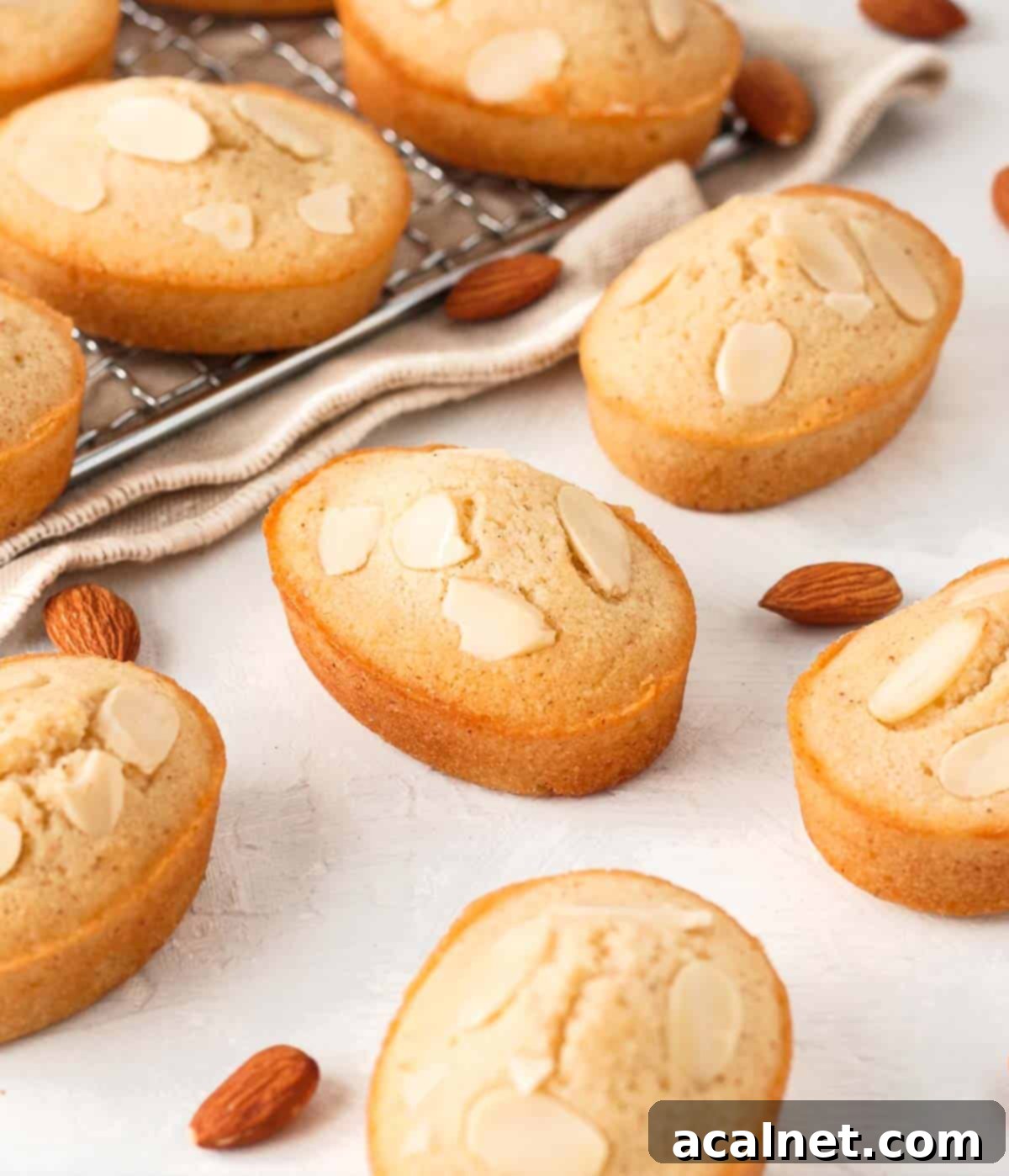
Discover More Delightful Mini Cake & Pastry Recipes
If you’ve enjoyed baking these exquisite French Financiers, you might be keen to explore other charming mini cakes and pastries that are perfect for tea time, desserts, or delightful gifts. Here are some more irresistible recipes to inspire your baking journey:
- Raspberry and Almond Madeleines
- Almond Shortbread Cookies
- Brioche Donuts
- Almond Flour Peanut Butter Cookies
- Mini Lemon Meringue Tarts
- Mini Brownie Bites
- Chocolate Chip Scones
- Cannelés de Bordeaux
- Chocolate Madeleines
I am so excited to share that my debut cookbook
“Bite-Sized French Pastries for the Beginner Baker”
is now available for purchase!
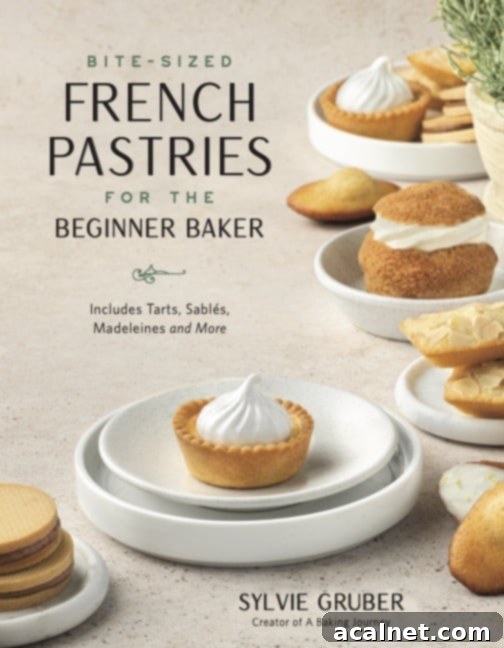
Full Recipe: Classic Financiers (Mini French Almond Cakes)

Financiers (Mini French Almond Cakes)
12 Cakes
Sylvie
20 minutes
14 minutes
34 minutes
Print Recipe
Ingredients
- 150 gr Unsalted Butter
- 25 gr Plain / All-Purpose Flour
- 125 gr Almond Meal
- 100 gr Icing Sugar, (or Powdered Sugar)
- 1 pinch Salt
- 5 Egg Whites, (about 150 grams)
- 1 teaspoon Vanilla Extract, (optional)
- Flaked Almonds, (optional, to taste)
Instructions
- Preheat your oven to 160°C (325°F). Generously grease a Financier Pan (see Note 1 below for alternative pans). Optionally, dust the pan with flour and tip out any excess for extra non-stick insurance.
- Prepare the Brown Butter: Place the unsalted butter in a small, light-colored saucepan. Turn the heat to low to medium-low. Cook until the butter has completely melted and begins to foam. Continue cooking, stirring occasionally, until the melted butter turns a golden-amber color and releases a rich, nutty aroma (this usually takes about 5 to 8 minutes). Once you observe small brown specks forming at the bottom of the saucepan, immediately remove it from the heat (see Note 2 below). Pour the brown butter into a heatproof bowl and set aside to cool down slightly.
- In a large mixing bowl, sift together the All-Purpose Flour, Almond Meal, Icing Sugar, and Salt. Whisk these dry ingredients together thoroughly to ensure they are well combined and lump-free.
- In a separate, clean bowl, lightly whisk the Egg Whites for a few minutes until they become slightly bubbly and form a light foam on top (see Note 3 below). This step adds air and contributes to a much lighter, airier, and more tender crumb in the finished financiers.
- Add the slightly cooled Brown Butter (including all the flavorful brown specks from the bottom of the saucepan) and Vanilla Extract (if using) to the bowl containing the dry ingredients. Mix with a whisk or spatula until just combined. Be careful not to over-mix the batter.
- Carefully transfer the financier batter into your prepared Financier Pan. You can use a piping bag for neatness, or simply spoon/scoop the batter into each mold. If needed, gently spread the batter with the back of a spoon to create an even surface. Optionally, top each financier with some Flaked Almonds for added texture and visual appeal.
- Bake for approximately 12 to 14 minutes, or until the financiers are lightly golden around the edges and spring back when gently touched in the center. If using mini loaf pans or muffin pans, you might need to adjust the baking time accordingly (likely a few more minutes for larger, or less for smaller). Remove from the oven and allow them to cool in their molds for about 10-15 minutes before gently removing them (see Note 4 below). Transfer the Financiers to a wire rack to cool completely before serving.
Video Tutorial
Notes
- Financier Pan Alternatives: If you don’t have a traditional financier pan, don’t worry! You can use any small cake pan, such as a regular or mini muffin pan, or a mini loaf pan. Just remember that the baking time will need to be adjusted based on the specific size and depth of your chosen molds. Always aim for a golden-brown finish and a cake that springs back when lightly pressed.
- The Essence of Brown Butter: The small brown specks you see forming at the bottom of the saucepan are caramelized milk solids. These are crucial for the distinctive nutty, rich flavor of brown butter. Make sure to scrape them all into your batter; they contain a concentrated burst of flavor that shouldn’t be discarded!
- Whisking Egg Whites for Lightness: This recipe does not use chemical raising agents like baking powder. Lightly whisking the egg whites until slightly bubbly incorporates air into the mixture, which then contributes to a much lighter, airier, and more tender crumb in the finished financiers. While optional, it’s highly recommended for the best texture. You can even whip them to soft peaks for an exceptionally fluffy cake, though this isn’t strictly traditional for financiers.
- Cooling and Releasing Financiers: Financiers are quite delicate when they first come out of the oven. Allowing them to cool in the pan for 10-15 minutes helps them to firm up, making them much easier to remove without breaking. If you find the cakes are still sticking to the pan, a small, thin knife can be gently run around the edges to release them before turning them out onto a wire rack to cool completely.
Nutrition (per serving)
Calories: 196kcal |
Carbohydrates: 12g |
Protein: 4g |
Fat: 15g |
Saturated Fat: 7g |
Polyunsaturated Fat: 1g |
Monounsaturated Fat: 3g |
Trans Fat: 1g |
Cholesterol: 27mg |
Sodium: 26mg |
Potassium: 28mg |
Fiber: 1g |
Sugar: 7g |
Vitamin A: 312IU |
Calcium: 26mg |
Iron: 1mg
Made this recipe?
Let us know if you liked it by leaving a comment below, and tag us on Instagram @a.baking.journey with a photo of your creation!
